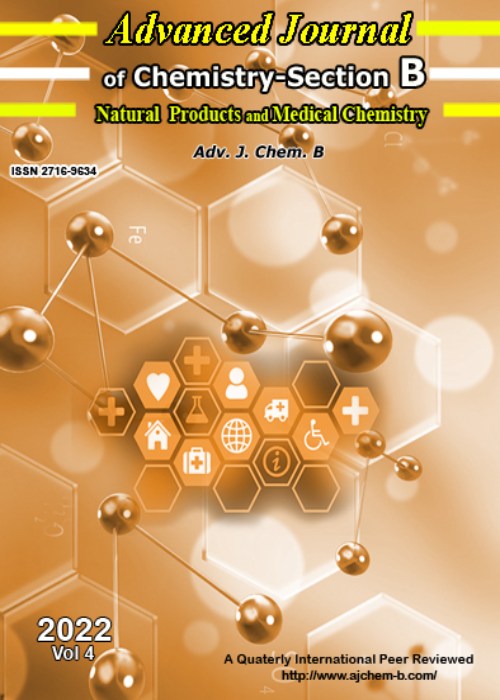Evaluation of Biosorption Potential of Opuntia fragalis Leaf for Decontamination of Cu(II) from Human Blood Plasma: Kinetic and Isotherm Studies
Author(s):
Article Type:
Research/Original Article (بدون رتبه معتبر)
Abstract:
Several heavy metals are found naturally in the earth’s crust and are exploited for various industrial and economic purposes. Among these heavy metals, a few have direct or indirect impact in the human body. Some of these heavy metals such as copper, cobalt, iron, nickel, magnesium, molybdenum, chromium, selenium, manganese, and zinc have functional roles which are essential for various diverse physiological and biochemical activities in the body. However, some of these heavy metals in high doses can be harmful to the body and in minute quantities have delirious effects on the body causing acute and chronic toxicities in humans. The process of removal of heavy metals is important due to their toxic effects on living organisms. Conventional methods possess many irreconcilable disadvantages pertaining to cost and efficiency. As a result, an in vitro laboratory-scale batch technique was employed to examine the removal efficacy of a novel unmodified natural biosorbent, Opuntia fragalis leaf (OFL) for detoxification of Cu(II) ions from human blood plasma. The outcome of detoxification of Cu(II) ions from human blood plasma using an unmodified biosorbent was accomplished by optimizing biosorption parameters such as biosorbent dosage, initial Cu(II) ions concentration, pH, and agitation time. The percentage of detoxification increases as the biosorption factors were increased with an optimum biosorbent dose of 2 g, initial Cu(II) ions concentration of 40 mg/L, pH of 6 and contact time of 60 minutes. The unmodified natural biosorbent was characterized to investigate the functional groups responsible for binding the Cu(II) ions from the blood plasma onto the biosorbent using Fourier Transform Infrared Spectroscopy. It was revealed that -N-O, -N-H, -C-C-, and -OH were accountable for Cu(II) ions detoxification from human blood plasma. Scanning electron microscopy (SEM) identified pores present on the biosorbent and revealed the biosorbent's outstanding surface chemistry. The experimental values were subjected to the Langmuir, Freundlich, and Temkin isotherms. The correlation of fitness, R2 (0.8231) value of the Langmuir isotherm model correlates best among the biosorption isotherms; thus, it best explains the detoxification process. Q0 for Langmuir monolayer coverage is 1.8103 mg/g which infers the maximum amount of Cu(II) ions biosorbed per pore site. The dimensionless factor RL= 0.0234 implies that the biosorption process is favourable. The Freundlich isotherm biosorption intensity, n is 1.9912 connotes the extent of binding affinity between the Cu (II) ions and the untreated biosorbent. The Temkin isotherm model yielded a biosorption heat of 6.4237 j/mol. In addition, the experimental data were subjected to multiple kinetic models to determine the rate of Cu(II) ions detoxification from human blood plasma. The pseudo-second order model fits best among the examined models, with the highest R2 value of 1.
Keywords:
Language:
English
Published:
Advanced Journal of Chemistry, Section B: Natural Products and Medical Chemistry, Volume:5 Issue: 3, Summer 2023
Pages:
223 to 243
magiran.com/p2616331
دانلود و مطالعه متن این مقاله با یکی از روشهای زیر امکان پذیر است:
اشتراک شخصی
با عضویت و پرداخت آنلاین حق اشتراک یکساله به مبلغ 1,390,000ريال میتوانید 70 عنوان مطلب دانلود کنید!
اشتراک سازمانی
به کتابخانه دانشگاه یا محل کار خود پیشنهاد کنید تا اشتراک سازمانی این پایگاه را برای دسترسی نامحدود همه کاربران به متن مطالب تهیه نمایند!
توجه!
- حق عضویت دریافتی صرف حمایت از نشریات عضو و نگهداری، تکمیل و توسعه مگیران میشود.
- پرداخت حق اشتراک و دانلود مقالات اجازه بازنشر آن در سایر رسانههای چاپی و دیجیتال را به کاربر نمیدهد.
In order to view content subscription is required
Personal subscription
Subscribe magiran.com for 70 € euros via PayPal and download 70 articles during a year.
Organization subscription
Please contact us to subscribe your university or library for unlimited access!


